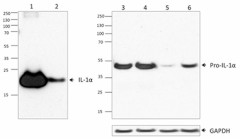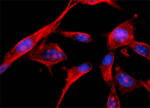- Clone
- A15032A (See other available formats)
- Regulatory Status
- RUO
- Other Names
- Interleukin 1, alpha, IL-1A, IL1F1
- Isotype
- Mouse IgG2a, κ
- Ave. Rating
- Submit a Review
- Product Citations
- publications

-

Western blot analysis of 50 ng recombinant human IL-1α (lane 1), recombinant mouse IL-1α (lane 2), THP-1 untreated (lane 3), THP-1 treated with PMA for three days, then LPS for one day (lane 4), and Raw264.7 untreated (lane 5) and Raw264.7 starved overnight and treated with LPS for one day (lane 6). Anti-IL-1α (clone A15032A) antibody was used, followed by HRP anti-mouse IgG secondary antibody. Purified anti-GAPDH antibody was used as a loading control. -

U87-MG cells were fixed with 4% paraformaldehyde (PFA) for ten minutes, permeabilized with 0.5% Triton X-100 for five minutes and blocked with 5% FBS for 30 minutes. Then the cells were intracellularly stained with 2 µg/mL anti-IL-1α (clone A15032A) antibody for two hours followed by 2 µg/mL Alexa Fluor® 594 conjugated goat anti-mouse IgG for one hour at room temperature. Nuclei were counterstained with DAPI (blue). The image was captured with a 60X objective.
IL-1 (Interleukin-1) is a central mediator of innate immunity and inflammation. The IL-1 family includes seven ligands with agonist activity (IL-1α and IL-1β, IL-18, IL-33, IL-36α, IL-36β, IL-36γ), three receptor antagonists (IL-1RA, IL-36RA, IL-38), and an anti-inflammatory cytokine (IL-37). A tight regulation through receptor antagonists, decoy receptors, and signaling inhibitors ensures a balance between amplification of innate immunity and uncontrolled inflammation. The cytokine IL-1α is a key molecule in the IL-1 family that induces autonomous proliferation in vascular smooth muscle cells, T cell activation during antigen presentation, up-regulation of monocyte/macrophage-mediated tumor cytotoxicity, stimulation of osteoclast formation, and production of proteinases in human chondrocytes. Furthermore, IL-1α is also an early and important mediator of inflammation after injury.
Product DetailsProduct Details
- Verified Reactivity
- Human
- Antibody Type
- Monoclonal
- Host Species
- Mouse
- Immunogen
- Human IL-1α, amino acids Ser113-Ala271 (Accession# NM_000575) was expressed in E. coli.
- Formulation
- Phosphate-buffered solution, pH 7.2, containing 0.09% sodium azide.
- Preparation
- The antibody was purified by affinity chromatography.
- Concentration
- 0.5 mg/ml
- Storage & Handling
- The antibody solution should be stored undiluted between 2°C and 8°C.
- Application
-
WB - Quality tested
ICC - Verified - Recommended Usage
-
Each lot of this antibody is quality control tested by Western blotting. For Western blotting, the suggested use of this reagent is 0.5 - 2.0 µg/ml. For immunocytochemistry, a concentration range of 1.0 - 5.0 μg/ml is recommended. It is recommended that the reagent be titrated for optimal performance for each application.
- Application Notes
-
Clone A15032A weakly reacts with mouse IL-1a.
- RRID
-
AB_2616884 (BioLegend Cat. No. 686502)
Antigen Details
- Structure
- 271 amino acids with the predicted molecular weight of approximately 31kD.
- Distribution
-
IL-1α is produced by monocytes, macrophages, keratinocytes, stimulated B lymphocytes, fibroblasts, endothelial cells, and epithelial cells.
- Function
- The cytokine IL-1α is a key molecule both in the innate and in the adaptive immune response. It induces autonomous proliferation in vascular smooth muscle cells, T cell activation during antigen presentation, up-regulation of monocyte/macrophage-mediated tumor cytotoxicity, stimulation of osteoclast formation, and production of proteinases in human chondrocytes.
- Interaction
- Stimulates thymocyte and B-cell proliferation.
- Ligand/Receptor
- Type I and II IL-1 receptors (IL-1RA and IL-1RB).
- Cell Type
- B cells, Neutrophils
- Biology Area
- Angiogenesis, Cancer Biomarkers, Cell Biology, Cell Cycle/DNA Replication, Cell Motility/Cytoskeleton/Structure, Cell Proliferation and Viability, Immunology, Innate Immunity, Signal Transduction
- Molecular Family
- Cytokines/Chemokines
- Antigen References
-
1. Ledford H. 2007. Nature 450:600.
2. Boraschi D, Tagliabue, A. 2006. Vitam. Horm. 74:229.
3. Shao J, Sheng H. 2007. J. Immunol. 178:4097.
4. Elaraj DM, et al. 2006. Clin. Cancer Res. 12:1088.
5. Schett G, et al. 2016. Nat. Rev. Rheumatol. 12:14.
6. Brough D, et al. 2015. IUBMB Life 67:323.
7. Dinarello CA, et al. 2014. Mol. Med. 20 Suppl. 1:S43-58.
8. Voronov E, et al. 2014. Front Physiol. 5:114.
9. Garlanda C, et al. 2013. Immunity 39:1003.
10. Rider P, et al. 2013. Semin. Immunol. 25:430. - Gene ID
- 3552 View all products for this Gene ID
- UniProt
- View information about IL-1alpha on UniProt.org
Related FAQs
Other Formats
View All IL-1α Reagents Request Custom Conjugation| Description | Clone | Applications |
|---|---|---|
| Purified anti-IL-1α | A15032A | WB,ICC |
Compare Data Across All Formats
This data display is provided for general comparisons between formats.
Your actual data may vary due to variations in samples, target cells, instruments and their settings, staining conditions, and other factors.
If you need assistance with selecting the best format contact our expert technical support team.









Follow Us